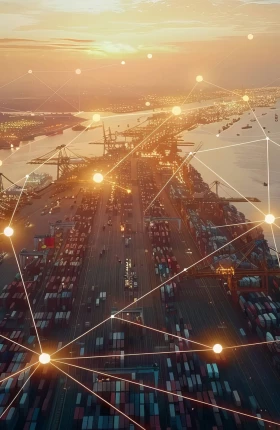Many global enterprises today have succeeded by following a simple recipe: procure, manufacture, and assemble in the lowest-cost locations; link these using reliable, standardized logistics and information technology; market the resulting products globally; and book profit in low-tax havens. This powerful formula for economic arbitrage enabled by technology and supported by the politics of open borders is the fruit of several decades of globalization. Today, all three elements of the equation not only are changing but also are subject to unprecedented levels of uncertainty.
The Standard Operating Model Is Under Threat
Multidimensional uncertainty has profound implications for the standard operating model of global business.
First, the potential for economic arbitrage is decreasing as a result of narrowing labor cost differentials across nations and increasing capital intensity of production, leading to a discernible trend of reshoring production. Direct-cost differentials in manufacturing between the US and the Yangtze River Delta in China, for instance, are now estimated to be only 1%. When indirect costs such as logistics are considered, many goods destined for the US market can now be manufactured more cheaply in the US. Whether this trend will persist or strengthen, however, is impossible to say given other uncertainties.
Second, technology promises to reshape further the conventional wisdom of global organization. Advanced manufacturing technologies with flatter supply curves create the possibility of more customization, closer to the market. We already see this in Adidas’s restoration of shoe production to Germany. In the near future, blockchain technologies, sensors, and the industrial Internet of Things promise smarter, more interconnected supply chains, likely leading to more competition on responsiveness. Furthermore, an increasing proportion of traded value will consist of data and digital services, whose economics are very different from those of physical products. When and exactly how these technological shifts will reshape global supply chains is likely to remain unknowable for some time.
Third, as if all that were not enough, the political context has become considerably more complex. In spite of the tremendous aggregate economic impact of globalization, inequality of income and opportunity has increased within nations enough to stoke nationalist sentiment. That in turn shapes political outcomes in ways that directly and materially affect trading arrangements. As a result, the UK voted to exit the European Union, and the new US administration announced the country’s withdrawal from the Trans-Pacific Partnership and threatened to impose tax penalties on imports. While these pronouncements are known, the terms and details of Brexit, renegotiated US trade deals, and new taxation arrangements are all currently unknown, and the reactions of trading partners to these and the knock-on effects on exchange rates and economic growth are essentially unknowable.
Current Practice Offers No Solution
The unpredictability stemming from these economic, technological, and political shifts is unlikely to decrease anytime soon, given the continued momentum of technology and the arithmetic of election cycles. The formula for the global enterprise itself—where to make what and how, as a function of technology, taxes, exchange rates, and trading arrangements—is up in the air.
The practice of supply chain management already tells us much about how to manage for modest short-term fluctuations—using buffers, keeping supply chains short, creating feedback loops, reducing cycle times, and reacting quickly, for example. These approaches, however, will be insufficient for managing deep systemic uncertainties on longer timescales. In such complex environments, uncertainty is multidimensional and change is continuous. As a result, the right response is not knowable in advance.
The paradigm for global business therefore has to change, at least for the time being. Leaders need to shift their attention from incrementally optimizing the efficiency of known, stable arrangements to addressing unknown and unknowable factors. They need to create organizational resilience and strategic optionality.
Six Lessons from Biology
What to do now? Biology can provide some inspiration. Biological systems, which have evolved the properties of robustness and resilience on multiple timescales, offer valuable lessons on how to manage under extreme uncertainty. Resilient biological and social systems display six characteristics, all of which are directly applicable to business.
- Redundancy. Duplication of elements (factories, stocks) may be inefficient but can provide a buffer against the unexpected. Functional redundancy offers a smarter route to the same end: if elements (plants) can be repurposed rapidly, then the costs of duplication are partially offset.
- Heterogeneity. Different types of elements (contract types, factory types and locations) make it possible to react to unexpected change and avoid correlated responses across a system, which can lead to total system failure. Diversity is also the substrate for evolutionary learning and adaptation to new situations, which increases strategic optionality.
- Modularity. Separate modules (subsidiaries, plants), loosely linked, can act like circuit breakers to help prevent the collapse of a system. With modularity, as with firebreaks in a forest, one portion can sustain damage while the integrity of the others is preserved. All else being equal, a highly uncertain situation favors a network of loosely linked parts rather than a centralized and tightly integrated system.
- Adaptation. Rapid adjustment to new circumstances protects a system against the negative effects of change. In the case of simple change, planned responses (such as contingency plans) can mitigate disruption if the system is sufficiently flexible and agile. For complex change, when the right response may not be analytically knowable, an adaptive approach comprising experimentation, selection, and amplification of successful outcomes can be effective. Global businesses’ supply chains therefore need to evolve to match changing circumstances, rather than being rigidly designed a priori.
- Prudence. While the future may not be foreseeable, downside scenarios can often be plausibly envisioned. The worst-case scenarios for taxes and trading regimes can be posited and used to stress test supply chain designs for economic viability. Current levels of uncertainty justify the investment in simulation models to permit such stress tests as well as the investment of management attention in scenarios and contingency plans.
- Embeddedness. Most systems are embedded within larger systems. A company is usually part of a multicompany system that converts inputs into products for end customers. And those larger systems are embedded within economies and political systems. Reciprocity and mutual benefit between levels are essential for stability and continuity. The impact on partner supply chains and on employment and skill building in local economies is therefore an important long-term consideration. The articulation of social purpose and contribution is also essential at a time when corporate capitalism is under scrutiny. Several US manufacturers are experiencing directly the importance of these broader issues as they run into strong political pressure to restore domestic manufacturing jobs allegedly lost to offshoring and technology.
Applying these biological principles is an art that requires experience and judgment. Balancing the principles is much harder than solving for known variables in a stable equation. But uncertainty should not be an excuse for inertia or a status quo bias; in biological evolution, selection has favored features that promote the ability to keep functioning in changing and unpredictable environments. Global companies that persist in optimizing the efficiency of a familiar, stable design, ignoring the shifts in the economic, technological, and political environment, risk becoming victims of change. Leaders should therefore embrace new biology-inspired ways to create resilient global organizations.
This article was originally published by Scientific American on March 17, 2017.





